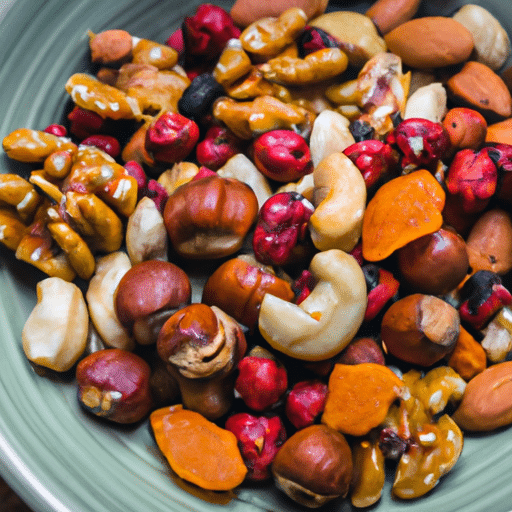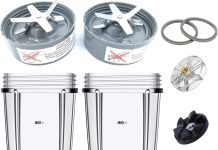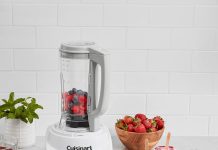In the quest for healthier alternatives, many of us have turned to blending as a way to incorporate nutrient-rich ingredients into our diets. But have you ever wondered if it’s safe to put nuts, seeds, and nut butters in a blender? Today, we’re here to give you the scoop on this pressing question. Stay tuned to discover the dos and don’ts of blending these protein-packed powerhouses, and get ready to take your smoothie game to the next level!
Review contents
Can You Put Nuts in a Blender?
Reasons to Blend Nuts
Blending nuts can be a great way to incorporate them into your culinary creations. Whether you are making a smoothie, a sauce, or a nut butter, blending nuts can help you achieve a smooth and creamy texture. Blending also enhances the flavor of nuts and makes them easier to incorporate into recipes. With a high-powered blender, you can achieve a fine consistency, which is especially useful when making nut butters.
Types of Nuts That Can Be Blended
Most nuts can be blended in a blender, but it’s important to consider their texture and oil content. Some commonly blended nuts include almonds, cashews, walnuts, pecans, and hazelnuts. These nuts have a higher oil content and softer texture, making them ideal for blending. Harder nuts like Brazil nuts and macadamia nuts may require soaking before blending to soften their texture.
Preparation Steps for Blending Nuts
Before blending nuts, it is important to prepare them properly to ensure a smooth blending process. Start by measuring the desired quantity of nuts and spreading them in a single layer on a baking sheet. Toast the nuts in the oven at 350°F for about 10 minutes, or until they turn golden brown and become fragrant. Allow the nuts to cool completely before transferring them to the blender.
Blending Tips for Nuts
When blending nuts, it is essential to follow a few tips to achieve the best results. Firstly, ensure that the blender is clean and dry before adding the nuts. This will prevent any unwanted flavors or odors from transferring to the nuts. Additionally, for a smoother blend, consider blending the nuts in smaller batches rather than all at once, especially if you are using a low-powered blender. Lastly, avoid blending the nuts for too long, as this can result in overheating and affect the taste and texture of the final product.
Can You Put Seeds in a Blender?
Benefits of Blending Seeds
Blending seeds can be a fantastic way to incorporate their nutritional benefits into your diet. Seeds are rich in essential vitamins, minerals, and healthy fats, making them an excellent addition to smoothies, baked goods, and other recipes. When blended, seeds release their nutrients more readily, making it easier for your body to absorb them.
Common Seeds Suitable for Blending
Many different types of seeds can be blended to enhance the flavor and nutritional content of your dishes. Some popular seeds suitable for blending include chia seeds, flaxseeds, sunflower seeds, pumpkin seeds, and hemp seeds. Each of these seeds offers its unique set of health benefits and can be easily incorporated into a variety of recipes.
Preparing Seeds for Blending
To prepare seeds for blending, it is often recommended to soak them beforehand. Soaking helps to soften the seeds, making it easier for the blender to break them down and release their nutrients. Simply place the desired quantity of seeds in a bowl and cover them with water. Allow them to soak for a few hours or overnight. After soaking, drain the water and rinse the seeds before adding them to the blender.
Blending Techniques for Seeds
When blending seeds, it is essential to choose the right blending technique to achieve the desired texture. For a smooth consistency, blend the seeds for a longer duration, gradually increasing the speed from low to high. If you prefer a slightly coarse texture, pulse the blender a few times to break down the seeds while still maintaining some texture. Experiment with different blending techniques to find the perfect result for your specific recipe.
Can You Put Nut Butters in a Blender?
Using a Blender for Nut Butters
Using a blender to make nut butters can be a convenient and cost-effective option. While dedicated nut butter machines or food processors are commonly used, blenders can still get the job done with great results. The key is to ensure that you have a high-powered blender that can handle the demands of blending nuts into a smooth, creamy butter.
Benefits of Making Nut Butters in a Blender
Making nut butter in a blender allows you to have complete control over the ingredients and customize the flavors according to your preferences. You can experiment with different combinations of nuts, add sweeteners or spices, and adjust the smoothness to your liking. Homemade nut butter also tends to be fresher and more economical compared to store-bought options.
Types of Nuts Suitable for Nut Butter
The type of nuts you choose will greatly impact the flavor and texture of your nut butter. Some popular options for homemade nut butter include almonds, cashews, peanuts, and macadamia nuts. Each nut has its distinct taste, so feel free to mix and match or stick to a single nut variety for a more pronounced flavor.
Steps to Make Nut Butter in a Blender
To make nut butter in a blender, start by adding the desired quantity of nuts to the blender jar. It is crucial to use a sufficient quantity of nuts to ensure proper blending. Turn on the blender at a slow speed and gradually increase it to high. The process may take a few minutes, and you may have to stop and scrape down the sides of the blender jar occasionally. Be patient, and continue blending until you achieve a smooth, creamy consistency.
Blender Requirements for Nut Butter
When making nut butter in a blender, it is important to have a high-powered blender with sharp blades and a strong motor. Blenders with a horsepower of around 2 or more are suitable for blending nuts into a smooth butter. Ensure that the blender jar is large enough to accommodate the nuts and has a secure lid to prevent any accidents during the blending process.
Choosing the Right Blender for Nuts, Seeds, and Nut Butters
Features to Consider in a Blender
When selecting a blender for blending nuts, seeds, and nut butters, there are a few key features to consider. Look for a blender with a high-powered motor, sharp blades, and variable speed settings. Additionally, a blender with a wide base and a secure lid will provide stability and prevent leaks during blending.
High-Speed Blenders for Nuts, Seeds, and Nut Butters
High-speed blenders are often the best option for blending nuts, seeds, and nut butters due to their powerful motors and sharp blades. These blenders can easily break down the tough fibers of nuts and seeds, resulting in a smooth and creamy texture. Look for blenders with speeds ranging from 10,000 to 30,000 RPM (revolutions per minute) for optimal blending results.
Blender Power and Motor Strength
The power and motor strength of a blender are crucial factors to consider when blending nuts, seeds, and nut butters. A higher wattage or horsepower indicates a more powerful blender that can easily handle the demands of blending tough ingredients. Aim for a blender with at least 1000 watts of power or a motor strength of 2 peak horsepower for efficient blending.
Blender Container and Blade Durability
The durability of the blender container and blades is another important aspect to consider, especially when blending nuts and seeds. Look for blenders with containers made of high-quality materials like BPA-free plastic or durable glass. Stainless steel blades are preferred for their sharpness and longevity. Ensure that the blender container and blades are dishwasher-safe for easy cleaning.
Cleaning and Maintenance Aspects
Consider the cleaning and maintenance requirements of a blender before making a purchase. Blenders with removable blade assemblies and dishwasher-safe containers make cleaning a breeze. Some blenders also come with self-cleaning functions, which can save time and effort. Additionally, look for blenders that offer warranty coverage to protect your investment.
Tips for Blending Nuts, Seeds, and Nut Butters
Optimal Blender Speed and Duration
Finding the optimal blender speed and duration for blending nuts, seeds, and nut butters is essential to achieve the desired consistency. Start at a low speed to break down larger pieces, then gradually increase the speed to blend the ingredients thoroughly. Blend for short intervals and pause to scrape down the sides of the blender jar, ensuring all the ingredients are evenly incorporated.
Adding Liquid or Oil for Better Blending
When blending nuts and seeds, adding a small amount of liquid or oil can help achieve a smoother consistency. This can be water, plant-based milk, or a neutral oil like coconut oil. The liquid lubricates the ingredients, making it easier for the blender to process them. Start with a small amount and add more if needed, being careful not to add too much and make the mixture too runny.
Blending Small or Large Quantities
Blending small quantities of nuts, seeds, or nut butters can be a bit challenging, as the ingredients may not come into contact with the blender blades properly. To overcome this, consider using a smaller blender container or an attachment specifically designed for processing smaller quantities. For larger quantities, ensure that the blender container has sufficient capacity and allows for proper circulation of the ingredients.
Avoiding Overheating in the Blender
While blending nuts, seeds, or nut butters, the blender can generate heat due to the friction created by the blades. To prevent overheating, it is important to blend in short bursts and avoid continuous blending for long periods. If you notice the blender or ingredients becoming too hot, pause and let them cool down before resuming blending. This will help maintain the integrity of the flavor and prevent any adverse effects on the final product.
Blender Safety Measures
Blenders can be powerful appliances, so it is crucial to follow safety measures when blending nuts, seeds, and nut butters. Always ensure that the blender is properly assembled before use and that the lid is securely in place. Avoid touching the moving blades while the blender is in operation. Additionally, never overload the blender with too many ingredients, as this can strain the motor and lead to overheating or damage.
Potential Challenges When Blending Nuts, Seeds, and Nut Butters
Blender Blade Clogging
When blending nuts and seeds, there is a possibility of the blender blades getting clogged or jammed. This can happen if the nuts or seeds are not fully broken down or if they clump together during blending. To prevent this, ensure that the nuts or seeds are evenly spread in the blender jar and blend in smaller batches if necessary. Stop the blender and use a spatula to scrape down the sides and loosen any stuck ingredients.
Difficulties with Certain Types of Nuts or Seeds
Not all nuts and seeds have the same texture or oil content, which can lead to different blending challenges. Harder nuts or seeds may require soaking before blending to soften their texture. In the case of very oily nuts, such as macadamia nuts, there may be more oil separation during blending, requiring additional blending or adjusting the recipe accordingly. Experiment with different techniques and ingredients to find the best approach for each type of nut or seed.
Lack of Smoothness or Creaminess in Nut Butters
Achieving a smooth and creamy texture in homemade nut butters can sometimes be challenging. If your nut butter turns out grainy or lacks the desired smoothness, try blending it for a longer duration. Adding a small amount of neutral oil, such as coconut oil, can also help achieve a smoother consistency. You can experiment with different blending times, techniques, and ingredients to find the perfect balance for your nut butter.
Separation or Oil Separation
Separation or oil separation can occur when blending certain nuts or nut butters, particularly those with a higher oil content. This is a natural process and can easily be remedied by stirring or mixing the blended mixture before use. You can also incorporate emulsifiers like lecithin or simply store the nut butter in a refrigerator to prevent oil separation. Give the nut butter a good stir before each use to ensure a consistent texture.
Preventing Nut Butter from Turning Bitter
If you are making nut butter in a blender, it is important to prevent it from turning bitter during the blending process. Overblending or blending for too long can cause the nuts to release their natural oils, which can turn bitter over time. To prevent this, avoid excessive blending and monitor the progress closely. Stop blending once you achieve the desired consistency, and store the nut butter in an airtight container to maintain its freshness.
Alternative Options for Processing Nuts, Seeds, and Nut Butters
Using a Food Processor
If you don’t have a blender or prefer a different method, a food processor can be a great alternative for processing nuts, seeds, and nut butters. Food processors often have a wider and more shallow bowl, which allows for better circulation and processing of ingredients. They also typically come with different blade attachments, making them versatile for various food preparation tasks.
Utilizing a Blender-Food Processor Combo
For those who want the best of both worlds, a blender-food processor combo can be a practical investment. These versatile appliances come with interchangeable containers and blades, allowing you to switch between blending and food processing tasks with ease. The blender attachment can be used for blending nuts, seeds, and nut butters, while the food processor attachment can handle other food preparation needs.
Considering a Nut Grinder
If you only plan to process small quantities of nuts or seeds, a nut grinder can be a handy tool. Nut grinders are specifically designed to grind nuts into a fine powder or paste and often come with different settings to achieve the desired consistency. They are compact, easy to use, and can be a cost-effective alternative if you don’t want to invest in a blender or food processor.
Manual Methods for Nut or Seed Processing
If you prefer a more hands-on approach, there are manual methods available for processing nuts or seeds. One such method is using a mortar and pestle to grind the nuts or seeds into a paste. While this process can be time-consuming and require some physical effort, it can be a satisfying and rewarding way to process smaller quantities.
Recipes and Ideas for Nuts, Seeds, and Nut Butters in a Blender
Homemade Nut Milk
Making your own nut milk at home is a breeze with a blender. Simply blend soaked nuts (such as almonds or cashews) with water, a pinch of salt, and any desired sweeteners or flavorings. Strain the mixture using a cheesecloth or a nut milk bag to remove any solids, and you’re left with a creamy and delicious homemade nut milk. You can enjoy it as is, add it to coffee or tea, or use it in recipes that call for milk.
Seed Blends for Baking
Blending different types of seeds together can create a flavorful and nutritious blend that can be used in baking or as a topping for various dishes. Combine seeds like sunflower seeds, pumpkin seeds, flaxseeds, and chia seeds in a blender and pulse until you achieve a coarse texture. This seed blend can be sprinkled on bread, cookies, or granola for a crunchy and nutritious twist.
Nut Butter Variations
With a blender, you can explore endless variations of nut butters by blending different nuts and adding flavorings. For example, blend almonds and a drizzle of honey for a classic almond butter or mix cashews and a pinch of sea salt for a creamy and savory cashew butter. You can also experiment with adding spices like cinnamon or cocoa powder for unique and delicious nut butter creations.
Energy Balls with Nuts and Seeds
Blending nuts and seeds is the perfect way to create nutritious and flavorful energy balls. Combine blended nuts and seeds with dates, nut butter, and additional flavorings like cocoa powder or shredded coconut. Roll the mixture into bite-sized balls and refrigerate until they firm up. These energy balls are a convenient snack option packed with protein, fiber, and healthy fats.
Smoothies with Nut and Seed Blends
Blending nuts and seeds into smoothies can add a creamy texture and enhance the nutritional content. Combine your favorite fruits, plant-based milk or yogurt, a handful of leafy greens, and a spoonful of nut or seed blend in a blender. Blend until smooth and creamy, and enjoy a delicious and nutrient-packed smoothie to start your day or refuel after a workout.
Blender Maintenance and Care for Nuts, Seeds, and Nut Butters
Cleaning the Blender Properly
Proper cleaning of the blender is crucial to maintain its performance and prevent any unwanted flavors or odors. After each use, disassemble the blender and rinse the container, lid, and blades with warm soapy water. Use a brush or sponge to remove any stubborn residue. Rinse thoroughly and allow all the components to dry completely before reassembling.
Removing Stains or Residue
Sometimes, nuts, seeds, or nut butters can leave stains or residue on the blender container or blades. To remove these, combine equal parts baking soda and water to create a paste. Apply the paste to the stained areas and let it sit for a few minutes. Scrub gently with a sponge or brush, then rinse thoroughly. This should help remove any stubborn stains or residue.
Maintaining Blade Sharpness
Sharp blender blades are essential for efficient blending. To maintain their sharpness, avoid blending extremely tough ingredients or ice cubes regularly, as this can dull the blades over time. If you notice any signs of dullness, you may need to replace the blades. Always refer to the manufacturer’s instructions regarding blade maintenance and replacement.
Storage of Blended Nut and Seed Products
Once you have blended nuts, seeds, or nut butters, proper storage is essential to maintain their quality and freshness. Store the blended products in airtight containers in a cool and dark place, such as a pantry or cupboard. Nut butters, in particular, should be refrigerated to prevent rancidity. Ensure that the containers are thoroughly cleaned and dried before transferring the blended products to prevent spoilage.
Conclusion
Blending nuts, seeds, and nut butters in a blender can open up a world of possibilities in the kitchen. From smoothies to energy balls, the versatility and convenience of blending make it an attractive option for incorporating these nutritious ingredients into your diet. With the right blender and proper techniques, you can achieve smooth and creamy results that will enhance the flavors and textures of your dishes. So don’t hesitate to put your blender to work and explore the endless combinations and creations that nuts, seeds, and nut butters have to offer!































